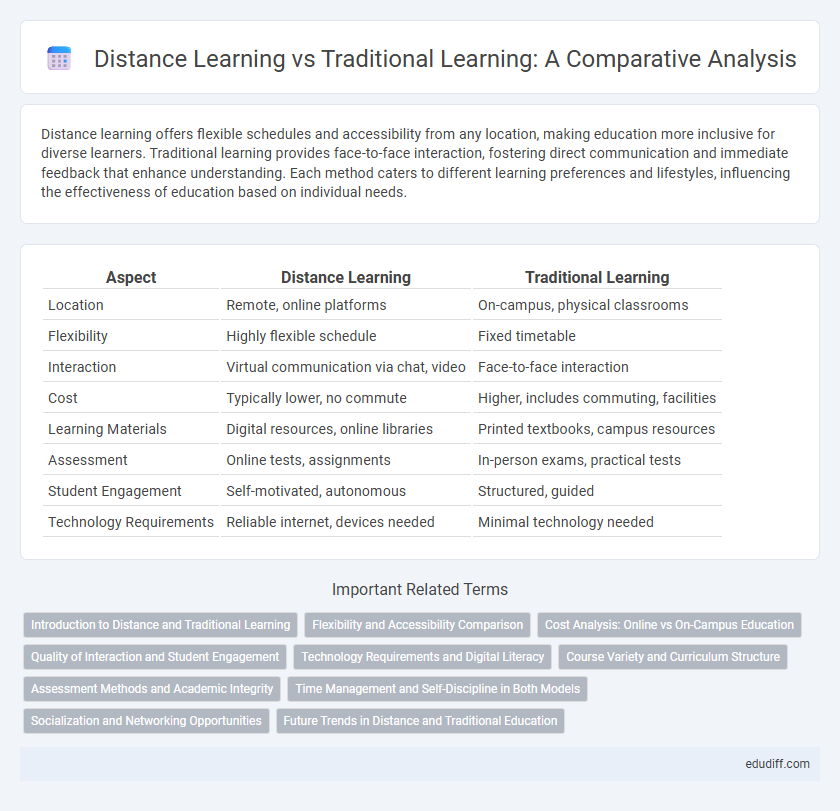Distance learning offers flexible schedules and accessibility from any location, making education more inclusive for diverse learners. Traditional learning provides face-to-face interaction, fostering direct communication and immediate feedback that enhance understanding. Each method caters to different learning preferences and lifestyles, influencing the effectiveness of education based on individual needs.
Table of Comparison
| Aspect | Distance Learning | Traditional Learning |
|---|---|---|
| Location | Remote, online platforms | On-campus, physical classrooms |
| Flexibility | Highly flexible schedule | Fixed timetable |
| Interaction | Virtual communication via chat, video | Face-to-face interaction |
| Cost | Typically lower, no commute | Higher, includes commuting, facilities |
| Learning Materials | Digital resources, online libraries | Printed textbooks, campus resources |
| Assessment | Online tests, assignments | In-person exams, practical tests |
| Student Engagement | Self-motivated, autonomous | Structured, guided |
| Technology Requirements | Reliable internet, devices needed | Minimal technology needed |
Introduction to Distance and Traditional Learning
Distance learning offers flexible access to educational resources through online platforms, enabling students to engage with coursework remotely and often asynchronously. Traditional learning typically involves in-person classroom instruction, providing direct interaction between instructors and students within a structured schedule. Both methods aim to deliver quality education but differ significantly in delivery format, accessibility, and student engagement models.
Flexibility and Accessibility Comparison
Distance learning offers unparalleled flexibility, allowing students to access course materials anytime and anywhere, accommodating diverse schedules and learning paces. Traditional learning typically requires fixed schedules and physical presence, which can limit accessibility for those with geographic, mobility, or time constraints. Online platforms expand educational opportunities globally, breaking down barriers that often restrict traditional classroom attendance.
Cost Analysis: Online vs On-Campus Education
Distance learning significantly reduces costs associated with commuting, housing, and campus fees compared to traditional on-campus education. Online programs often offer more affordable tuition rates and eliminate expenses related to physical materials, making them a cost-effective alternative. Traditional learning typically involves higher overhead costs, including infrastructure maintenance and on-campus services, which contribute to increased overall student expenses.
Quality of Interaction and Student Engagement
Distance learning leverages digital tools to facilitate interactive experiences such as live video discussions, real-time quizzes, and collaborative online projects, enhancing student engagement despite physical separation. Traditional learning offers face-to-face interactions that enable immediate feedback, non-verbal communication, and spontaneous discussions, fostering deeper personal connections. Studies show that while traditional settings often promote higher quality interaction, well-designed distance learning environments with interactive platforms can achieve comparable student engagement and meaningful participation.
Technology Requirements and Digital Literacy
Distance learning demands reliable internet access, up-to-date devices, and proficiency with various digital platforms, making technology requirements significantly higher than traditional learning. Successful participation hinges on students' digital literacy, encompassing skills in navigating learning management systems, online collaboration tools, and multimedia content. Traditional learning relies less on technology, emphasizing face-to-face interaction and physical resources, which may limit the development of digital competencies.
Course Variety and Curriculum Structure
Distance learning offers a broader course variety, enabling access to specialized subjects and programs not always available in traditional learning institutions. Curriculum structures in distance education are often more flexible, allowing learners to study at their own pace and tailor their schedules to personal needs. Traditional learning typically follows a fixed curriculum with set timelines, providing structured guidance and direct interaction with instructors and peers.
Assessment Methods and Academic Integrity
Distance learning relies heavily on online assessments such as timed quizzes, open-book exams, and project-based evaluations to measure student performance, often integrating plagiarism detection software to uphold academic integrity. Traditional learning typically employs in-person exams, oral presentations, and supervised assessments, offering direct proctoring to minimize cheating. Both modalities face unique challenges in maintaining fairness and accuracy, with distance education increasingly adopting advanced proctoring technologies and authentication protocols to ensure assessment validity.
Time Management and Self-Discipline in Both Models
Distance learning demands strong self-discipline and effective time management as students must independently organize study schedules and meet deadlines without direct supervision. Traditional learning offers structured class times and in-person interactions, providing external motivation that can enhance timely task completion but may limit flexibility. Mastery of these skills in both models directly influences academic success and student engagement.
Socialization and Networking Opportunities
Distance learning offers flexibility but often limits spontaneous social interactions and networking opportunities compared to traditional learning environments. Traditional classrooms facilitate face-to-face communication, group projects, and campus events that enhance social skills and professional connections. Students in physical settings benefit from immediate peer support and diverse networking platforms crucial for career development.
Future Trends in Distance and Traditional Education
Emerging technologies like AI-driven personalized learning and virtual reality simulations are transforming distance education, making it more immersive and tailored to individual needs. Traditional learning environments are increasingly integrating digital tools and hybrid models to enhance engagement and flexibility. Future trends indicate a convergence where both distance and traditional education adopt innovative approaches to optimize accessibility, interactivity, and student outcomes.
Distance Learning vs Traditional Learning Infographic

 edudiff.com
edudiff.com